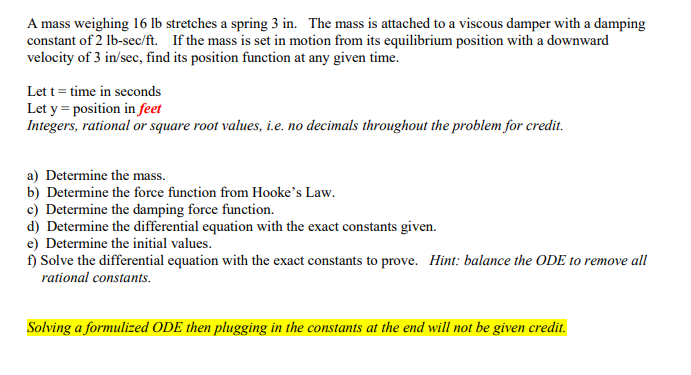A mass weighing 16 lb stretches a spring 3 in. The mass is attached to a viscous damper with a damping constant of 2 lb-sec/ft. If the mass is set in motion from its equilibrium position with a downward velocity of 3 in/sec, find its position function at any given time. Let t = time in seconds Let y = position in feet Integers, rational or square root values, i.e. no decimals throughout the problem for credit. a) Determine the mass. b) Determine the force function from Hooke's Law. c) Determine the damping force function. d) Determine the differential equation with the exact constants given. e) Determine the initial values. f) Solve the differential equation with the exact constants to prove. Hint: balance the ODE to remove all rational constants. Saluiua lisad O DE h dit
A mass weighing 16 lb stretches a spring 3 in. The mass is attached to a viscous damper with a damping constant of 2 lb-sec/ft. If the mass is set in motion from its equilibrium position with a downward velocity of 3 in/sec, find its position function at any given time. Let t = time in seconds Let y = position in feet Integers, rational or square root values, i.e. no decimals throughout the problem for credit. a) Determine the mass. b) Determine the force function from Hooke's Law. c) Determine the damping force function. d) Determine the differential equation with the exact constants given. e) Determine the initial values. f) Solve the differential equation with the exact constants to prove. Hint: balance the ODE to remove all rational constants. Saluiua lisad O DE h dit
Related questions
Question
please show work for understanding

Transcribed Image Text:A mass weighing 16 lb stretches a spring 3 in. The mass is attached to a viscous damper with a damping
constant of 2 lb-sec/ft. If the mass is set in motion from its equilibrium position with a downward
velocity of 3 in/sec, find its position function at any given time.
Lett = time in seconds
Let y = position in feet
Integers, rational or square root values, i.e. no decimals throughout the problem for credit.
a) Determine the mass.
b) Determine the force function from Hooke's Law.
c) Determine the damping force function.
d) Determine the differential equation with the exact constants given.
e) Determine the initial values.
f) Solve the differential equation with the exact constants to prove. Hint: balance the ODE to remove all
rational constants.
Solving a formulized ODE then plugging in the constants at the end will not be given credit.
Expert Solution
This question has been solved!
Explore an expertly crafted, step-by-step solution for a thorough understanding of key concepts.
Step by step
Solved in 4 steps
